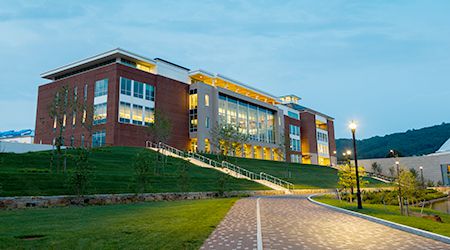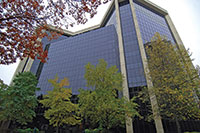view all Case Studies
Lighting Control Systems Play Large Role in Campus Rebuilding Plan

Construction projects at Liberty University focus on state-of-the-art facilities with advanced building systems that maximize energy efficiency such as smart, expandable, automatic lighting control systems.
August 17, 2015 -
Lighting
Liberty University in Lynchburg, Va., is in the midst of a $500 million campus rebuilding plan designed to promote a sense of community, encourage stewardship through energy conservation, enhance academic opportunity, and establish the institution firmly in the conversation about prominent, national universities.
Campus-wide, construction projects focus on state-of-the-art facilities with advanced building systems that maximize energy efficiency such as smart, expandable, automatic lighting control systems.
Beginning with the new Jerry Falwell Library, which included nearly 300 wireless occupancy/vacancy sensors and controls, Liberty adopted the Lutron wireless protocol as the campus standard for energy-saving, advanced lighting systems. These systems not only improve the total campus environment, they reduce energy bills, and those savings are passed on to student programs.
The projects include vacancy sensors throughout Residential Commons I and II, and lighting and shade control systems in the Science Hall, LaHaye Student Union, and DeMoss Student Center.
Project challenge
Charles Spence, senior vice president for planning and construction, takes a long-term view of campus expansion. One of his goals for the rebuilding projects was to standardize on a system that provides essential, beautiful lighting and shade control and can be expanded easily as the university continues to grow.
“Networked, digital controls allowed us to standardize across the campus and deliver customized results depending on the specific building purpose and the way occupants utilize lighting control,” Spence says. “The wireless systems also help us reduce installation and materials cost, and meet aggressive construction timelines while ensuring that systems deliver comfortable, energy-efficient light.”
Spence chose Lutron standalone wireless and Quantum Total Light Management systems to deliver energy savings and provide the ability to measure and analyze lighting use. Wireless protocols help to future-proof the system, allowing changes and reprogramming without rewiring, or otherwise disrupting the previously installed controls.
Creating better spaces
Much of the campus is using advanced lighting control strategies to maximize energy efficiency and enhance personal comfort. In the Jerry Falwell Library, occupancy sensors are broadly used to ensure that lights are not left on when a space is vacant, but that people are not ever left in the dark when they are in the space.
In residence halls, simple wireless vacancy sensors in each room reduce energy waste without relying on students remembering to turn off the lights, but students can still turn lights on and off from convenient, wireless wall controls. To create more vibrant, welcoming spaces at any time of the day, the university installed integrated lighting and shade control solutions that automatically change according to time of day and daylight availability.
Networked, digital control offers the ability to standardize across the campus and deliver customized results depending on the specific building purpose and the way occupants utilize lighting control. Wireless systems also made it possible to reduce installation and materials cost and meet aggressive construction time lines while ensuring that the systems deliver comfortable, energy-efficient lighting.
Liberty is strongly committed to sustainable technologies. LED lamps and controls are used throughout the campus to reduce lighting electricity costs. Integrated, solar adaptive shading systems in academic buildings and public areas automatically adjust according to the position of the sun in order to take greatest advantage of daylight, reduce HVAC costs, and create a dynamic environment for students, staff, and visitors.
Liberty has deployed an aggressive lighting control strategy to maximize energy savings in its facilities. The use of vacancy sensors in many areas maximizes the amount of time the lighting is in the off state, while providing the appropriate amount of light in areas only when they are occupied.
Daylight harvesting where windows are present adds to this savings by turning lights down or off when the space is occupied and natural daylight is present. The ability to control the daylight contribution though automated window shades ensures daylight is managed to reduce glare and heat, and always maximize the occupants’ comfort.
This reduction in heat also delivers energy savings by reducing the HVAC cooling requirements for the building. The combination of these strategies is targeted to reduce the lighting energy requirements by 65 percent.
Liberty facilities planning and management will be conducting a study for 2015-2016 comparing the energy consumption in prior student housing locations and those new building that utilize lighting control technology. Lutron Electronics Quantum technology interoperable with current building management systems will now provide a campus wide solution for monitoring and measuring energy utilization.
Many of the controls utilized in the lighting and shade control strategies above are wireless. This allows installation teams to stay ahead of aggressive construction schedules by minimizing labor, material & waste when compared to wired solutions. The labor savings estimates are significant, eliminating 70 percent of the labor from the installation of similar, wired controls.
Next
Read next on FacilitiesNet












